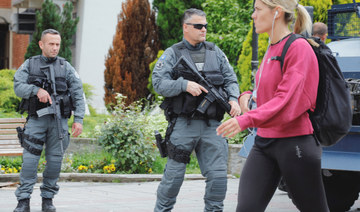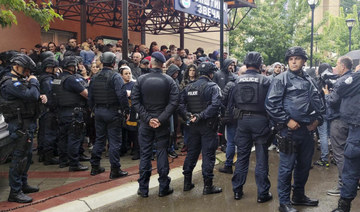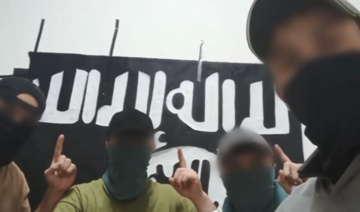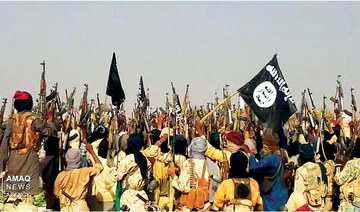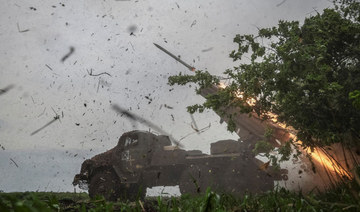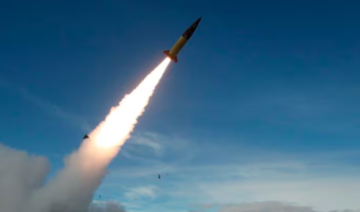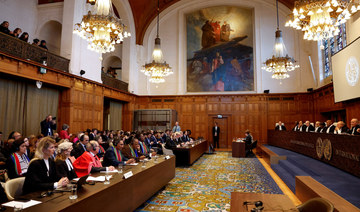LEPOSAVIC, Kosovo: Around 25 NATO peacekeeping soldiers defending three town halls in northern Kosovo were injured in clashes with Serb protesters on Monday, while Serbia’s president put the army on the highest level of combat alert.
KFOR, the NATO-led peacekeeping mission to Kosovo, condemned the violence.
“While countering the most active fringes of the crowd, several soldiers of the Italian and Hungarian KFOR contingent were the subject of unprovoked attacks and sustained trauma wounds with fractures and burns due to the explosion of incendiary devices,” it said in a statement.
Hungary’s defense minister Kristof Szalay-Bobrovniczky said that 7 Hungarian soldiers were seriously injured and that they will be taken to Hungary for treatment. He said 20 soldiers were injured. Italian soldiers were also injured in clashes.
“What is happening is absolutely unacceptable and irresponsible,” Italy’s Giorgia Meloni said in a statement. “It is vital to avoid further unilateral actions on the part of the Kosovar authorities and that all the parties in question immediately take a step back to ease the tensions.”
Serbian President Aleksandar Vucic said that 52 Serbs were injured, three of them seriously.
Kosovo President Vjosa Osmani accused Serbian counterpart Aleksandar Vucic of destabilising Kosovo.
“Serb illegal structures turned into criminal gangs have attacked Kosovo police, KFOR (peacekeeping) officers & journalists. Those who carry out Vucic’s orders to destabilize the north of Kosovo, must face justice,” Osmani tweeted.
Vucic accused Kosovo Prime Minister Albin Kurti of creating tensions. He called on Serbs in Kosovo to avoid clashes with NATO soldiers.
The tense situation developed after ethnic Albanian mayors took office in northern Kosovo’s Serb majority area after elections the Serbs boycotted — a move that led the US and its allies to rebuke Pristina on Friday.
In Zvecan, one of the towns, Kosovo police — staffed by ethnic Albanians after Serbs quit the force last year — sprayed pepper gas to repel a crowd of Serbs who broke through a security barricade and tried to force their way into the municipality building, witnesses said.
Serb protesters in Zvecan threw tear gas and stun grenades at NATO soldiers. Serbs also clashed with police in Zvecan and spray-painted NATO vehicles with the letter “Z,” referring to a Russian sign used in war in Ukraine.
In Leposavic, close to the border with Serbia, US peacekeeping troops in riot gear placed barbed wire around the town hall to protect it from hundreds of angry Serbs.
Later in the day protesters threw eggs at a parked car belonging to the new Leposavic mayor.
Vucic, who is the commander-in-chief of the Serbian armed forces, raised the army’s combat readiness to the highest level, Defense Minister Milos Vucevic told reporters.
“This implies that immediately before 2:00 p.m. (1200 GMT), the Serbian Armed Forces’ Chief of the General Staff issued additional instructions for the deployment of the army’s units in specific, designated positions,” Vucevic said, without elaborating.
NATO peacekeepers also blocked off the town hall in Zubin Potok to protect it from angry local Serbs, witnesses said.
Igor Simic, deputy head of the Serb List, the biggest Belgrade-backed Kosovo Serb party, accused Kosovo Prime Minister Albin Kurti of fueling tensions in the north.
“We are interested in peace. Albanians who live here are interested in peace, and only he (Kurti) wants to make chaos,” Simic told reporters in Zvecan.
Serbs, who comprise a majority in Kosovo’s north, have never accepted its 2008 declaration of independence from Serbia and still see Belgrade as their capital more than two decades after the Kosovo Albanian uprising against repressive Serbian rule.
Ethnic Albanians make up more than 90 percent of the population in Kosovo as a whole, but northern Serbs have long demanded the implementation of an EU-brokered 2013 deal for the creation of an association of autonomous municipalities in their area.
Serbs refused to take part in local elections in April and ethnic Albanian candidates won the mayoralties in four Serb-majority municipalities — including North Mitrovica, where no incidents were reported on Monday — with a 3.5 percent turnout.
Serbs demand that the Kosovo government remove ethnic Albanian mayors from town halls and allow local administrations financed by Belgrade resume their work.
On Friday, three out of the four ethnic Albanian mayors were escorted into their offices by police, who were pelted with rocks and responded with tear gas and water cannon to disperse the protesters.
The United States and its allies, which have strongly backed Kosovo’s independence, rebuked Pristina on Friday, saying imposing mayors in Serb-majority areas without popular support undercut efforts to normalize relations.
Kurti defended Pristina’s position, tweeting after a weekend phone call with the European Union’s foreign policy chief: “Emphasized that elected mayors will provide services to all citizens.”
Serbian Foreign Minister Ivica Dacic told RTS it was “not possible to have mayors who have not been elected by Serbs in Serb-majority municipalities.”
After meeting Kurti, US ambassador to Kosovo Jeffrey Hovenier told reporters: “We are concerned about reports today about violence against official property.”
“We’ve seen pictures of graffiti against KFOR cars and police cars, we’ve heard about attacks on journalists, we condemn that, that is not appropriate response.”
NATO soldiers injured in Kosovo clashes with Serb protesters
https://arab.news/vse2x
NATO soldiers injured in Kosovo clashes with Serb protesters
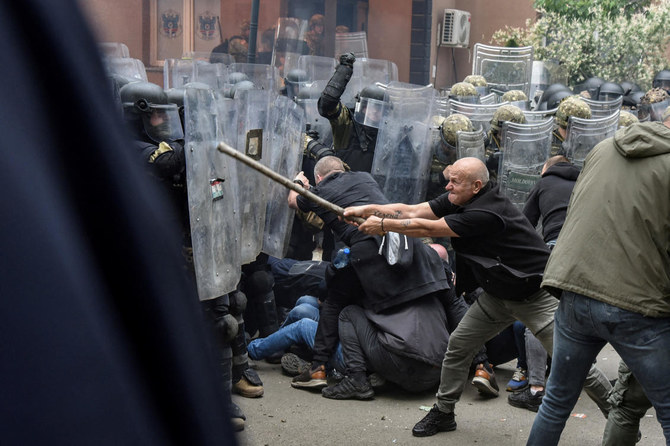
- KFOR: ‘Several soldiers of the Italian and Hungarian KFOR contingent were the subject of unprovoked attacks and sustained trauma wounds with fractures and burns’
- Serbian President Aleksandar Vucic said that 52 Serbs were injured, three of them seriously
UK to build memorial to Muslim soldiers who fought in world wars
- Monument, featuring Islamic calligraphy, will reflect ‘incredible narrative,’ architect says
- About 8m Muslim soldiers and laborers stood alongside Allied forces
LONDON: The UK is building a war memorial to the millions of Muslim soldiers who served alongside British and Commonwealth forces during the two world wars, Sky News reported.
The 13.2-meter-tall monument, which has been several years in the planning, will stand at the National Memorial Arboretum in Staffordshire. Built from brick and terracotta it will be inscribed with the personal stories of the soldiers.
About 2.5 million Muslim soldiers and laborers served in the militaries of the Allied powers during the First World War and about 5.5 million in the Second World War.
Benny O’Looney, the memorial’s architect, said: “The idea is, as you approach the memorial, it draws you in. And you can see there’s more detail, more information, more craftsmanship.
“The idea is to show a panorama of the Muslim soldiers’ service in the world war from gritty 1914 — this incredible narrative of plugging the gap and saving the expeditionary forces on the Western Front.”
The inspiration for the design, which features Islamic calligraphy, came from journeys to the Indian subcontinent, O’Looney said.
The monument will be erected on a site already containing memorials to Sikhs, Gurkhas and others.
Irfan Malik, a doctor from Nottingham whose ancestors served in both world wars, said: “I’m so glad we are near to fruition now, so that we can remember this forgotten history of the Muslim soldiers in both of the great wars and looking at Muslim contributions globally as well.
“Both of my great-grandfathers — Capt. Ghulam Mohammad and Subedar (roughly equivalent to warrant officer) Mohammad Khan — were part of the Great War and my two grandfathers were part of the Second World War, serving in Burma.
“They all descended from Dulmial village, which is based in the salt range in Punjab in present-day Pakistan, a very famous military village.”
The memorial would serve as a “symbol of remembrance of those campaigns, the sacrifices made and also an opportunity to educate our younger generation to improve community cohesion in this country,” Malik said.
France charges Daesh official’s ex-wife with crimes against humanity
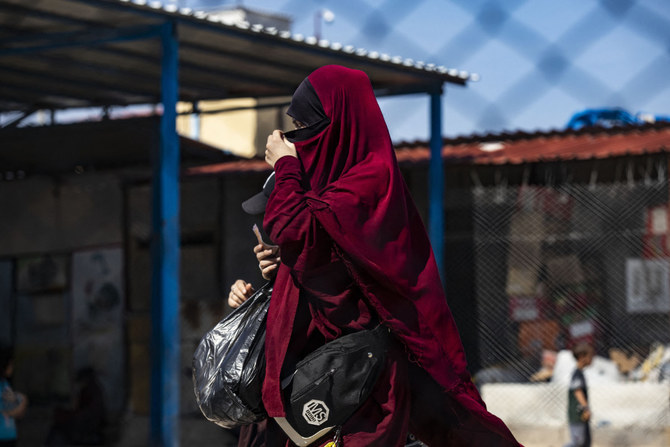
- The woman identified only as Sonia M. was accused by a Yazidi woman of raping her twice and knowing that her husband was raping her, Le Parisien reported
- The Yazidi woman was 16 when she was taken captive by Daesh militants and forced into slavery by top Daesh official Abdelnasser Benyoucef
PARIS: France has charged the ex-wife of a top Daesh official with crimes against humanity on suspicion of enslaving a teenage Yazidi girl in Syria, French media reported.
A woman identified as Sonia M., the former wife of the jihadist group’s head of external operations Abdelnasser Benyoucef, was charged on March 14, Le Parisien said Saturday.
The Yazidi woman, who was 16 when she was forced into slavery by Benyoucef, accused Sonia M. of raping her twice and knowing that her husband was raping her, the report said.
The woman, now 25, said she was held for more than a month in 2015 in Syria, where she was not allowed to eat, drink or shower without Sonia M.’s permission.
Sonia M. denied the allegations against her in a March 14 interview with French investigators, saying “only one rape” had been committed by her former husband.
The teenager “left her room freely, ate what she wanted, went to the toilet when she needed to,” she said in her interview, seen by AFP.
Sonia M.’s lawyer Nabil Boudi slammed the charges as “opportunistic accusations,” saying that prosecutors were seeking “to make her responsible for the most serious crimes, because the courts have not managed to apprehend the real perpetrators.”
An arrest warrant has been issued for Benyoucef, according to a source close to the investigation.
France launched an investigation in 2016 into genocide, crimes against humanity and war crimes committed against ethnic and religious minorities in Iraq and Syria since 2012.
The probe has focused on crimes suffered by members of the Yazidi and Christian communities as well as members of the Sheitat tribe, according to France’s PNAT anti-terror unit.
“The aim is to document these crimes and identify the French perpetrators who belong to the Islamic State organization,” PNAT told AFP.
US announces $6 billion in security aid for Ukraine
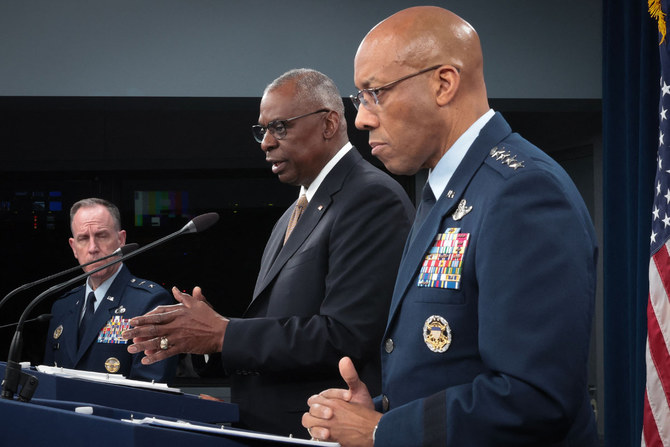
- The package is the second this week, following another valued at $1 billion
- Ukraine’s President Volodymyr Zelensky said the US delay in approving new assistance has been costly for Kyiv
WASHINGTON: Defense Secretary Lloyd Austin on Friday announced the United States will provide key air defense munitions and artillery rounds to Ukraine as part of a $6 billion military aid package that is its largest ever for Kyiv.
The package is the second this week, following another valued at $1 billion that was announced just after US President Joe Biden signed a much-delayed bill to provide new funding for Ukraine as it struggles to hold back Russian advances.
“This is the largest security assistance package that we’ve committed to date,” Austin told journalists following the conclusion of a virtual meeting of dozens of Kyiv’s international supporters.
“They need air defense interceptors, they need artillery systems and munitions. They need... armored vehicles, they need maintenance and sustainment. So all of those kinds of things are included” in the package,” he said.
Ukraine has in recent months pleaded for more air defenses from its Western allies as it struggles to fend off a surge in deadly attacks on civilian infrastructure, and the new package includes interceptors for both Patriot and NASAMS air defense systems.
But unlike the $1 billion package announced Wednesday, which featured items that will be drawn from US stocks, the latest assistance will be procured from the defense industry, meaning it will take longer to arrive on the battlefield.
Speaking at the opening of the virtual meeting, Ukraine’s President Volodymyr Zelensky said the US delay in approving new assistance has been costly for Kyiv.
“While we were waiting for a decision on the American support, the Russian army managed to seize the initiative on the battlefield,” Zelensky said.
“We can still now not only stabilize the front, but also move forward, achieving our Ukrainian goals in the war,” he said, while noting that “Ukrainian defenders need your sufficient and timely support.”
A senior US defense official said this week that “Ukrainian forces have been rationing their ammunition for quite some time, rationing their capabilities.”
Aid from the United States and other countries “will enable the Ukrainians to begin to retake the initiative,” but “this will not be a rapid process,” the official said on condition of anonymity.
“The Ukrainians will need to rebuild quite a bit to take on board all of these new supplies... and ensure that they can defend their positions. So I would not forecast any large-scale offensive in the near-term,” the official added.
The United States has been a key military backer of Ukraine, committing tens of billions of dollars in security assistance since Russia launched its full-scale invasion in February 2022.
But prior to this week, Washington had announced new aid for Ukraine on just one other occasion this year, a $300 million package in March that was only made possible by using money that the Pentagon had saved on other purchases.
A squabbling Congress had not approved large-scale funding for Kyiv for nearly a year and a half, but eventually took action starting last week after months of acrimonious debate among lawmakers over how or even whether to help Ukraine defend itself.
The US House of Representatives on April 20 approved legislation authorizing $95 billion in aid funding, including $61 billion for Ukraine, while the Senate passed the measure on Tuesday and Biden signed it into law the following day.
It’s 30 years since apartheid ended. South Africa’s celebrations are set against growing discontent
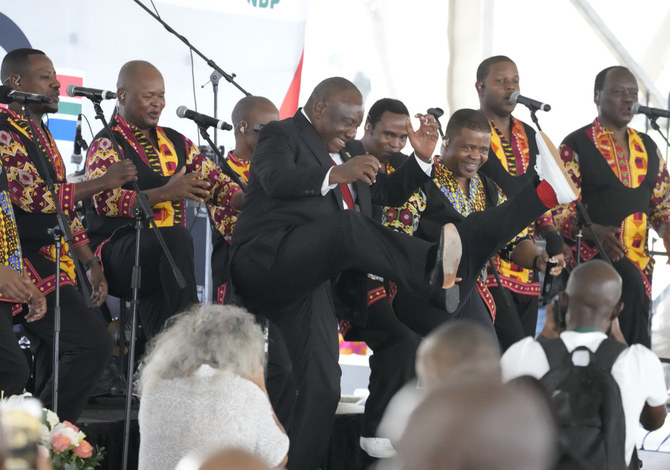
- South Africa is still the most unequal country in the world in terms of wealth distribution, according to the World Bank, with race a key factor
- While the damage of apartheid remains difficult to undo, the ANC is increasingly being blamed for South Africa’s current problems
PRETORIA: South Africa marked 30 years since the end of apartheid and the birth of its democracy with a ceremony in the capital Saturday that included a 21-gun salute and the waving of the nation’s multicolored flag.
But any sense of celebration on the momentous anniversary was set against a growing discontent with the current government.
President Cyril Ramaphosa presided over the gathering in a huge white tent in the gardens of the government buildings in Pretoria as head of state.
He also spoke as the leader of the African National Congress party, which was widely credited with liberating South Africa’s Black majority from the racist system of oppression that made the country a pariah for nearly a half-century.
The ANC has been in power ever since the first democratic, all-race election of April 27, 1994, the vote that officially ended apartheid.
But this Freedom Day holiday marking that day fell amid a poignant backdrop: Analysts and polls predict that the waning popularity of the party once led by Nelson Mandela is likely to see it lose its parliamentary majority for the first time as a new generation of South Africans make their voices heard in what might be the most important election since 1994 next month.

“Few days in the life of our nation can compare to that day, when freedom was born,” Ramaphosa said in a speech centered on the nostalgia of 1994, when Black people were allowed to vote for the first time, the once-banned ANC swept to power, and Mandela became the country’s first Black president. “South Africa changed forever. It signaled a new chapter in the history of our nation, a moment that resonated across Africa and across the world.”
“On that day, the dignity of all the people of South Africa was restored,” Ramaphosa said.
The president, who stood in front of a banner emblazoned with the word “Freedom,” also recognized the major problems South Africa still has three decades later with vast poverty and inequality, issues that will be central yet again when millions vote on May 29. Ramaphosa conceded there had been “setbacks.”
The 1994 election changed South Africa from a country where Black and other nonwhite people were denied most basic freedoms, not just the right to vote. Laws controlled where they lived, where they were allowed to go on any given day, and what jobs they could have. After apartheid fell, a constitution was adopted guaranteeing the rights of all South Africans no matter their race, religion, gender or sexuality.
But that hasn’t significantly improved the lives of millions, with South Africa’s Black majority that make up more than 80 percent of the population of 62 million still overwhelmingly affected by severe poverty.
The official unemployment rate is 32 percent, the highest in the world, and more than 60 percent for young people between the ages of 15 and 24. More than 16 million South Africans — 25 percent of the country — rely on monthly welfare grants for survival.
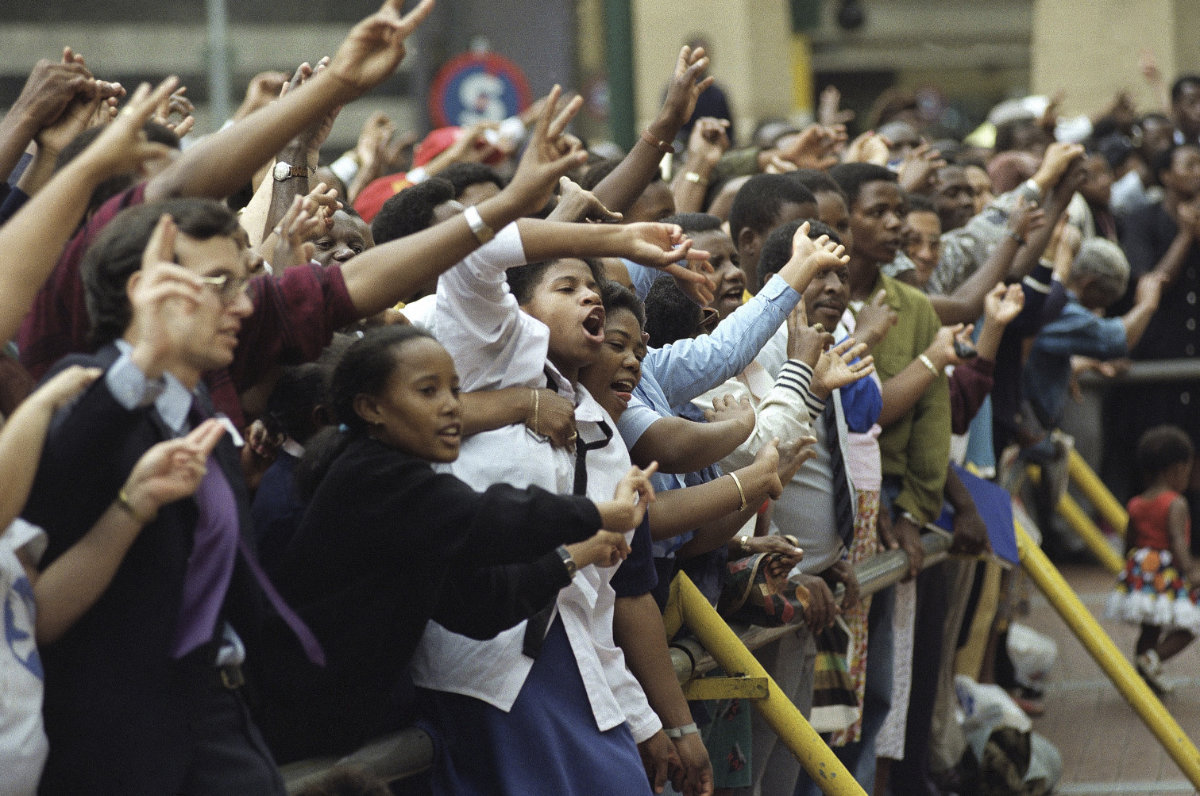
South Africa is still the most unequal country in the world in terms of wealth distribution, according to the World Bank, with race a key factor.
While the damage of apartheid remains difficult to undo, the ANC is increasingly being blamed for South Africa’s current problems.
In the week leading up to the anniversary, countless South Africans were asked what 30 years of freedom from apartheid meant to them. The dominant response was that while 1994 was a landmark moment, it’s now overshadowed by the joblessness, violent crime, corruption and near-collapse of basic services like electricity and water that plagues South Africa in 2024.
It’s also poignant that many South Africans who never experienced apartheid and are referred to as “Born Frees” are now old enough to vote.
Outside the tent where Ramaphosa spoke in front of mostly dignitaries and politicians, a group of young Black South Africans born after 1994 and who support a new political party called Rise Mzansi wore T-shirts with the words “2024 is our 1994” on them. Their message was that they were looking beyond the ANC and for another change for their future in next month’s election.
“They don’t know what happened before 1994. They don’t know,” said Seth Mazibuko, an older supporter of Rise Mzansi and a well-known anti-apartheid activist in the 1970s.
“Let us agree that we messed up,” Mazibuko said of the last 30 years, which have left the youngsters standing behind him directly impacted by the second-worst youth unemployment rate in the world behind Djibouti.
He added: “There’s a new chance in elections next month.”
US intel suggests Putin may not have ordered Navalny death in prison: WSJ

- The Russian prison service said that Navalny collapsed on February 16 after a walk at the isolated camp
WASHINGTON: US intelligence agencies believe that while the Russian president was ultimately responsible for the death of opposition leader Alexei Navalny, he didn’t order it to take place when it did, the Wall Street Journal reported Saturday.
The finding, which the Journal said was based on both classified intelligence and an analysis of public facts, raises new questions about Navalny’s death in a remote Arctic prison camp, which led to a new round of sanctions against President Vladimir Putin’s Russia.
Among those facts was the timing of the opposition leader’s death in mid-February, which overshadowed Putin’s reelection a month later.
While the new finding does not question Putin’s responsibility for Navalny’s death, the CIA and other US intelligence agencies believe he probably didn’t order it “at that moment,” the Journal said, quoting people familiar with the matter.
It said that some European officials, briefed on the US finding, were skeptical that the 47-year-old dissident could have been targeted without Putin’s prior knowledge, given the tight controls in today’s Russia.
President Joe Biden and several other world leaders have publicly expressed little doubt about the matter. “Make no mistake. Putin is responsible for Navalny’s death,” Biden said after the stunning news of the death emerged.
The Russian prison service said that Navalny collapsed on February 16 after a walk at the isolated camp. It said attempts to revive him failed.
Navalny had seemed relatively healthy and in good spirits when seen in a video just a day earlier.
A week before that, he reportedly had been the subject of high-level talks over a potential prisoner swap that could have freed him.
Navalny had been serving a 19-year prison sentence on charges he and his backers insist were fabricated.
He had earlier survived a poisoning that US and other investigators blamed on the Kremlin. Russian officials have denied culpability in the poisoning or in his death.
A number of prominent Kremlin opponents have died, been jailed and or forced into exile in recent years.
Reached by AFP, the National Security Council declined to comment on the report.



